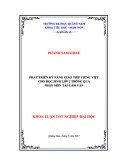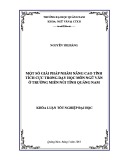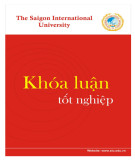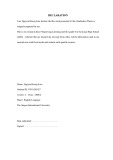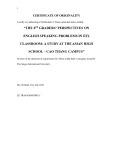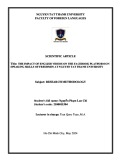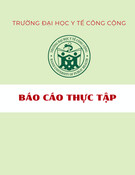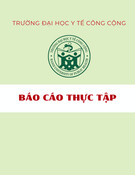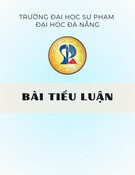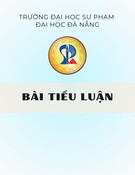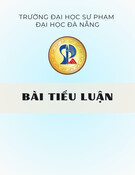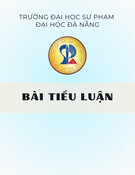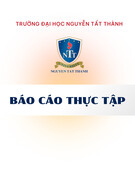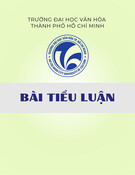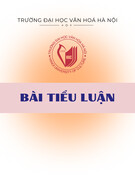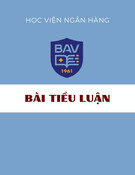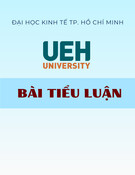
TRƯỜNG ĐẠI HỌC HÀNG HẢI VIỆT NAM
KHOA NGOẠI NGỮ
THUYẾT MINH
ĐỀ TÀI NCKH CẤP TRƯỜNG
ĐỀ TÀI
COMPILING TEACHING SUPPLEMENTARY
MATERIALS FOR CROSS – CULTURAL
COMMUNICATION COURSE
FOR ENGLISH MAJOR STUDENTS
AT VIETNAM MARITIME UNIVERSITY
(Xây dựng tài liệu giảng dạy bổ trợ môn Giao tiếp giao văn
hóa cho sinh viên chuyên ngữ trường Đại học Hàng Hải Việt
Nam)
Chủ nhiệm đề tài: Ths. Nguyễn Thị Thúy Thu
Hải Phòng, tháng 5/2016

CONTENT
INTRODUCTION ............................................................................................ 1
1. Rationale .................................................................................................. 1
2. Aims of the study .................................................................................... 1
3. Significance of the study ......................................................................... 1
4. Methodology of the study ........................................................................ 2
5. Scope of the study ................................................................................... 3
6. Design of the study .................................................................................. 3
DEVELOPMENT ............................................................................................. 4
CHAPTER 1: UNDERSTANDING CROSS – CULTURAL
COMMUNICATION ........................................................................................ 4
1.1. Definition of culture ............................................................................... 4
1.1.1. Language .......................................................................................... 4
1.1.2. Culture .............................................................................................. 4
1.1.3. The components of culture ............................................................... 6
1.2. Definition of Communication ................................................................. 7
1.3. Communication competence (CC) ......................................................... 8
1.4. The definition of cross-cultural communication .................................... 9
1.5. Culture shock and how to avoid culture shock? ................................... 10
1.5.1. Culture schock? Why culture shock? ............................................. 10
1.5.2. Main factors creating culture shock ............................................... 12
1.5.3. How culture - shock: From honey moon to Culture shock to
integration ................................................................................................. 12
1.5.4. How to cope with culture shock? ................................................... 14
1.6. Practice.................................................................................................. 15
CHAPTER 2: CULTURE IMPACTS ON NON – VERBAL
COMMUNICATION ...................................................................................... 20

2.1. Understanding non-verbal communication .......................................... 20
2.2. The importance of nonverbal communication ...................................... 21
2.3. Types of nonverbal communication ..................................................... 22
2.3.1. Gestures .......................................................................................... 22
2.3.2. Postures ........................................................................................... 29
2.4. Cross-cultural nonverbal communication and culture shock ............... 31
CHAPTER 3:CULTURE IMPACTS ON VERBAL COMMUNICATION . 33
3.1. Addressing forms in Vietnamese language and culture ....................... 33
3.1.1. Circular Relationship ...................................................................... 34
3.1.2. Horizontal Relationship- Type 1 .................................................... 34
3.1.4. Dynamic Relationships ................................................................... 36
3.1.5. The dynamic relationship-type II ................................................... 38
3.1.6.The variant of circular relationship. ................................................ 39
3.2. Addressing forms in English - American language and culture ........... 40
3.2.1. Addressing forms in English - American ....................................... 40
3.2.2. Terms of affection .......................................................................... 42
3.3. Objectiveness and Subjectiveness ........................................................ 43
3.3.1. Definition of objectiveness and subjective ..................................... 43
3.3.2. Objectiveness and Subjectiveness in defining the space ................ 43
3.3.3. Subjective and objective in pragmatics .......................................... 44
3.4. Directness and indirectness .................................................................. 45
3.4.1. Directness ....................................................................................... 45
3.4.2. Indirectness ..................................................................................... 46
3.5. Politeness .............................................................................................. 49
3.5.1.What is politeness? .......................................................................... 49
3.5.2.What is FTA?................................................................................... 50
3.5.3. Speech atcs ..................................................................................... 51
3.5.4. Politeness principles ....................................................................... 52
3.5.5. Politeness strategies ........................................................................ 53

3.5.6. Bald on record – without redressive action .................................... 54
3.5.7. Positive politeness strategies .......................................................... 55
3.5.8. Negative politeness strategies ........................................................ 57
CONCLUSION ............................................................................................... 61
1. Major findings ....................................................................................... 61
2. Implications for English language teaching .......................................... 61
3. Limitations ............................................................................................. 64
4. Further study .......................................................................................... 64
REFERENCES ............................................................................................... 65
In English ..................................................................................................... 65
In Vietnamese .............................................................................................. 66
Website ........................................................................................................ 67

LIST OF FIGURES IN THE STUDY
LIST OF FIGURES
PAGE
Figure 1: Levine and adalman’s iceburg of culture
7
Figure 2: Classification of Communication
8
Figure 3: W-shaped diagram of culture shock
13
Figure 4: Circular Relationship
34
Figure 5: Horizontal Relationship- Type 2. Nguyen
Quang (1999:165)
36
Figure 6: Dynamic relationship type-I
37
Figure 7: Dynamic relationship type-II
38
Figure 8: Dynamic relationship type-II cited in Nguyen
Quang (1999:175)
39
Figure 9: Variant of circular relationship.
40
Figure 10: Possible strategies for doing FTAs (Brown
and Levinson, 1987)
53
Figure 11: Strategies to minimize risk of losing face
(Nguyen Quang, 1999:130)
54

